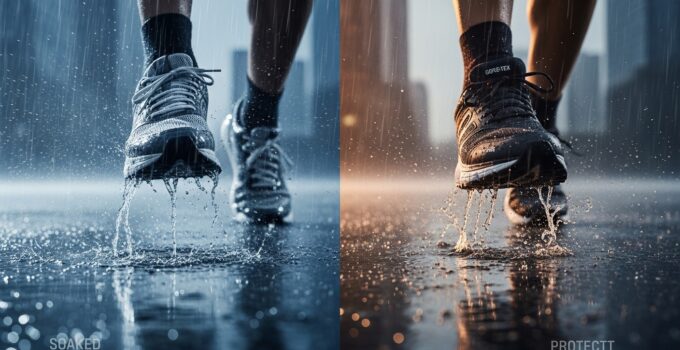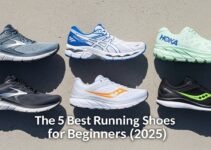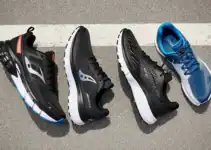Let’s be honest. The only thing worse than the squish… squish… squish… of a soaked running shoe in a cold downpour is the feeling of your foot boiling in a non-breathable one. When you run in wet weather, your feet are going to get wet somehow, whether it’s from the outside or sweat building up on the inside.
Buying a waterproof running shoe isn’t a magic fix; it’s a trade-off. A waterproof membrane, like the popular GORE-TEX (GTX), is great at keeping rain and slush out, but it inherently sacrifices some breathability. It’s a specialized tool meant for specific conditions.
First, let’s clear up a common mistake: if you’re looking for “waterproof running boots,” you’re almost certainly looking for waterproof running shoes. A traditional boot is usually heavy, stiff, and engineered to restrict ankle movement for hiking or work, not for running. If you’re planning to hike (not run), check our Best Waterproof Hiking Boots guide instead.








This guide breaks down exactly when to pull the trigger on a waterproof shoe, when you should skip it, and reviews the best models our team has tested so you can focus on the run, not aching, soggy feet.
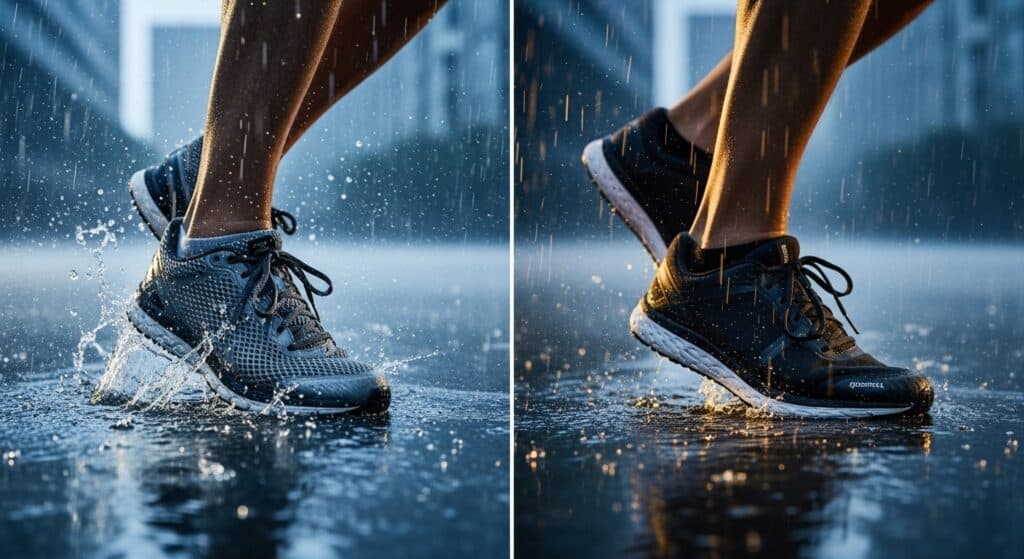
Waterproof running shoes are a specialized tool for cold, wet conditions.
Quick Picks: Top 6 Waterproof Running Shoes (2025)
| Award | Shoe Model | Best For | Key Feature |
|---|---|---|---|
| 🏆 Best Overall (Road) | Brooks Ghost 17 GTX | The reliable daily trainer for wet pavement | Balanced Cushioning, GORE-TEX Invisible Fit |
| 🛡️ Best Overall (Trail) | Hoka Speedgoat 6 GTX | Sloppy, wet technical trails & maximum cushion | Vibram Megagrip, GORE-TEX Invisible Fit |
| 🏔️ Best “Boot” Hybrid | Salomon X Ultra 5 Mid GTX | Fast hiking / Light running with ankle support | Stability, Surefootedness, Mid-cut design |
| 🏃 Best All-Around Trail | ASICS GEL-TRABUCO 13 GTX | Reliable protection and all-around grip | Solid traction, rock plate, moderate cushion |
| ❄️ Best for Ice & Snow | Salomon Spikecross 6 GTX | Icy surfaces and packed snow | Tungsten Carbide Metal Spikes on Outsole |
| 💰 Best Value Pick | Nike Winflo 11 GTX | Affordable wet-weather road running | Plush midsole, Fantastic Gore-Tex upper for the price |
The Waterproof Running Shoe Buyer’s Guide: The Honest Truth
Our experience running in everything from freezing rain to tropical downpours has taught us one crucial lesson: waterproof shoes are a tool for a specific job. Here’s the deal on when they work, and when they fail.
When to Use Waterproof Shoes
- Cold Weather: If the temperature is below 50°F (10°C), the waterproof membrane helps block wind and traps heat, which is essential when the ground is wet, slushy, or covered in light snow.
- Shallow Puddles & Wet Grass: For runs where you are primarily splashing on wet roads, gravel, or through dewy grass, the waterproof upper effectively keeps the moisture out.
- Freezing Rain or Slush: When getting wet means getting dangerously cold, waterproof shoes provide critical protection against frostbite and discomfort.
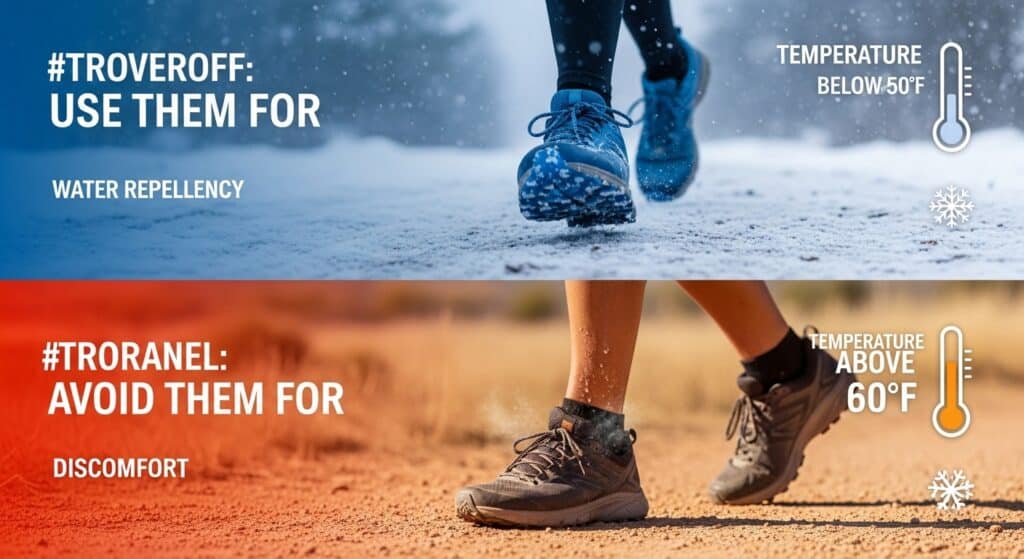
Waterproof shoes are ideal for cold, wet weather (left), while mesh shoes are better for warm rain (right).
When to AVOID Waterproof Shoes (The Sweat Bucket Problem)
- Warm/Hot Rain (Above 50°F / 10°C): This is the biggest catch. When you run hard and it’s warm, your feet produce sweat. That sweat gets trapped inside the shoe because the membrane can’t vent vapor fast enough. You end up with feet soaked in sweat, which takes forever to dry and leads straight to blisters.
- Deep Creek Crossings: If water goes over the shoe’s ankle collar, it will pour in and get trapped. Since the shoe is designed to keep water out, it now acts like a bucket, keeping the water in. In this situation, drainage is key, not waterproofing.
- Running Long Distances in Warm Weather: Prioritize breathability over waterproofing for long runs where heat and internal moisture buildup are major concerns.
⚠️ The “Bathtub Effect” Warning
Waterproof shoes have a fatal flaw: once water gets over the ankle cuff (from a deep puddle, creek crossing, or heavy rain running down your leg), it’s trapped inside by the waterproof membrane. Your shoe becomes a water-filled boot that will never drain.
The Solution: If you know you’ll encounter water above ankle-height, skip waterproof entirely and use the “Embrace the Wet” strategy (mesh shoes + merino wool socks).
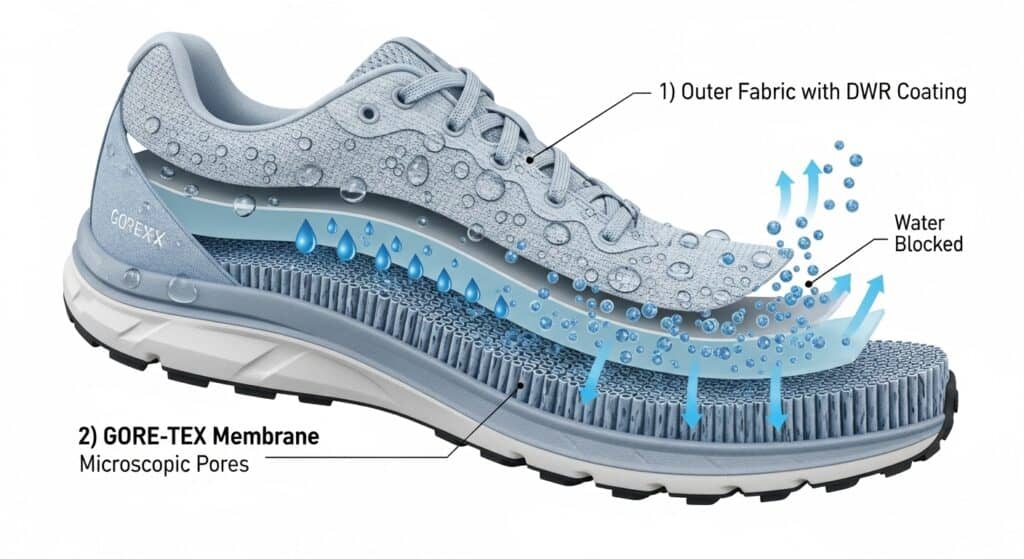
A GORE-TEX membrane stops liquid water (rain) but allows sweat vapor to escape.
How Waterproofing Technology Works
GORE-TEX (GTX): The Gold Standard
GORE-TEX is a membrane with billions of microscopic pores. Each pore is 20,000 times smaller than a water droplet, so liquid water cannot enter. However, the pores are large enough for water vapor molecules (your sweat) to escape. This is why it’s “waterproof yet breathable.”
The Catch: “Breathable” doesn’t mean “cool.” The membrane still restricts airflow compared to open mesh, so your feet will be warmer and sweatier. This is why we only recommend waterproof shoes for cold weather (below 50°F / 10°C).
Proprietary Membranes
Some brands use their own waterproof membranes (like KEEN.DRY or Dry-Core). These are often very good and slightly cheaper than GORE-TEX, but GORE-TEX remains the benchmark for proven breathability and reliability.
DWR (Durable Water Repellent)
This is the coating on the outside of the shoe that makes water bead up and roll off. DWR is not waterproofing—it’s a protective layer that prevents the outer fabric from getting saturated (which would reduce breathability). DWR wears off over time and needs to be reapplied.
Traction: The Wet-Surface Problem
A waterproof upper is only half the battle. You need excellent grip.
- Wet Roads and Pavement: Look for soft rubber and specialized tread designs (like Nike’s Storm-Tread rubber) that perform well when slick.
- Wet Rocks and Mud: This requires aggressive technology. We look for deep lugs (3 to 6 millimeters) and materials like Vibram Megagrip or soft PWRTRAC rubber compounds. The Vibram Megagrip outsole on the Hoka Speedgoat 6 GTX is the gold standard.
- Ice and Packed Snow: Standard rubber fails on ice. You need metal. The Salomon Spikecross 6 GTX uses tungsten carbide spikes that bite into frozen surfaces.
Other Key Features to Look For
- Gusseted Tongue: The tongue is attached to the upper on both sides, stopping water from leaking in through the laces. This is non-negotiable in a true waterproof shoe.
- Gaiter Traps: A hook or D-ring for attaching a gaiter to keep snow and debris out. Essential for winter trail running.
The “Embrace the Wet” Strategy: A Better Alternative?
For warmer rain or unavoidable deep water crossings, many experienced runners (including us) skip waterproof shoes entirely. Here is the simple, practical strategy:
- Wear a highly breathable mesh shoe (non-waterproof).
- Pair it with high-quality thin merino wool socks.
Why it Works: Your feet will get wet, but merino wool insulates even when wet (keeping your feet warm), and the shoe drains instantly because there’s no waterproof liner trapping the water. You go from being “miserably soaked” to “comfortably wet” after a few minutes.
Pro Tip: Waterproof Shoes + Gaiters = Ultimate Protection
For trail runners who need maximum protection against water entering from above, pair a waterproof shoe with waterproof trail gaiters. This creates a sealed system from mid-calf down to your toes.
Recommended Setup: Salomon Spikecross 6 GTX + Outdoor Research Rocky Mountain High Gaiters = bombproof winter trail system.
Critical Note: Since waterproof soles are often thin and flexible, traditional gaiters with an under-sole strap can ruin ground-feel. Opt for strapless gaiter designs when possible.
Detailed Reviews of the 6 Best Waterproof Running Shoes (2025)
We’ve tested these models across various conditions to see how they truly perform when the weather turns nasty.
1. Brooks Ghost 17 GTX (Best Overall for Road)
Honest Take: This is your perfect shoe if you need predictable comfort and neutral support for wet road running. It uses GORE-TEX Invisible Fit technology, which is bonded directly to the upper. This keeps the shoe feeling lighter and more flexible than older waterproof designs, so it doesn’t feel like a heavy brick. The 10mm drop is great for reducing knee pressure, a feature we love for high-mileage runners.
Pros & Cons
| Pros | Cons |
|
|
Best For: Daily road runners who need a reliable, comfortable waterproof trainer for cold, wet pavement.
Key Specs: Weight: 11.3 oz (M), Drop: 10mm, Price: ~$160
Check Price on Brooks Ghost 17 GTX →
2. Hoka Speedgoat 6 GTX (Best Overall for Trail)
Honest Take: If you love Hoka’s generous cushion and need to tackle rugged, wet, technical trails, the Speedgoat 6 GTX is a beast. It keeps the aggressive Vibram Megagrip outsole with 5mm lugs, giving you superior bite on loose soil, mud, and slick rock. However, the waterproof membrane makes the shoe noticeably stiffer and impacts breathability, confirming that it’s best reserved for cold, wet climates (below 50°F / 10°C) rather than warm ones.
Pros & Cons
| Pros | Cons |
|
|
Best For: Trail runners in cold, wet, or slushy conditions who need maximum cushioning and grip.
Key Specs: Weight: 10.4 oz (M9), Drop: 5mm, Outsole: Vibram Megagrip with 5mm lugs, Price: ~$185
Check Price on Hoka Speedgoat 6 GTX →
3. Salomon X Ultra 5 Mid GTX (Best “Boot” Hybrid)
Honest Take: This isn’t strictly a running shoe; it’s a backpacking/hiking boot that crosses over well for fast hiking or light trail running where you need support and waterproof coverage above the ankle. It provides the stability and surefootedness of a hiking boot without all the bulk. It’s ideal if you’re mixing short runs with long, technical day hikes, especially on moderately challenging terrain.
Pros & Cons
| Pros | Cons |
|
|
Best For: Fast hikers and trail runners who need ankle support and coverage for technical, rocky terrain.
Key Specs: Weight: 12.2 oz (M), Drop: 8mm, Price: ~$170
Check Price on Salomon X Ultra 5 Mid GTX →
4. ASICS GEL-TRABUCO 13 GTX (Best All-Around Trail)
Honest Take: If you need a true trail-ready option that delivers reliable waterproofing and solid protection, the Trabuco 13 GTX does the job. It features a rock plate for underfoot defense and ASICSGRIP™ technology for good traction on varied terrain. This shoe maintains a solid, trail-ready feel while offering moderate cushioning. It’s a versatile all-around trail shoe that won’t break the bank.
Pros & Cons
| Pros | Cons |
|
|
Best For: Trail runners who want a reliable, versatile waterproof shoe for moderate to technical trails without maximal cushioning.
Key Specs: Weight: 10.2 oz (M), Drop: 8mm, Price: ~$150
Check Price on ASICS GEL-TRABUCO 13 GTX →
5. Salomon Spikecross 6 GTX (Best for Ice & Snow)
Honest Take: If you are running on packed snow or actual ice, a standard rubber lug is going to fail you—you need metal. The Spikecross 6 GTX is basically a Salomon Speedcross 6 chassis that has been upgraded with tungsten carbide metal spikes mounted on the soft rubber outsole lugs. This is the only shoe on this list specifically capable of tackling icy surfaces because the studs bite into the freeze. It’s a stable shoe with a secure fit and a waterproof gaiter built in. Warning: Do not wear these indoors or on dry pavement, as the metal cleats will damage flooring, cause you to slip, and wear down prematurely.
Pros & Cons
| Pros | Cons |
|
|
Best For: Dedicated winter runners in snowy, icy climates who need guaranteed traction on frozen surfaces.
Key Specs: Weight: 10.6 oz (M), Drop: 6mm, Spikes: 12 tungsten carbide studs, Price: ~$200
Check Price on Salomon Spikecross 6 GTX →
6. Nike Winflo 11 GTX (Best Value Pick)
Honest Take:This is not a performance shoe; The Winflo 11 GTX is our best affordable waterproof running shoe option, offering a plush, comfortable feel and a reliable GORE-TEX upper for only $130. The massive stack gives it a soft feel and the non-breathable upper is actually perfect for cold, rainy weather, insulating heat effectively (it scored a 1/5 for breathability in testing—which is actually a feature in winter). it’s a comfort-first, budget-friendly option for casual runners who need dry feet.
Pros & Cons
| Pros | Cons |
|
|
Best For: Budget-conscious runners who need basic waterproof protection for casual, cold-weather road running.
Key Specs: Weight: 10.2 oz (M), Drop: 10mm, Price: ~$130
Check Price on Nike Winflo 11 GTX →
How to Care for Your Waterproof Shoes (Don’t Ruin the Membrane!)
You’ve invested $140-200 in a waterproof shoe. Here’s how to maximize its lifespan and keep the membrane functioning properly.

Cleaning mud off your shoes and drying them properly is crucial for membrane life.
Essential Maintenance
- Clean Them Gently: Mud and dirt can clog the membrane’s microscopic pores, reducing breathability. After muddy runs, rinse with cool water and use a soft brush to remove debris. Never use harsh detergents or put them in a washing machine.
- Dry Them CORRECTLY: NEVER put waterproof shoes on a radiator, heater, or use a hairdryer. High heat (above 100°F / 40°C) can delaminate the membrane and melt adhesives. Always air dry, or use a gentle, low-heat boot dryer.
- Re-Apply DWR Coating: If you notice water is “soaking in” to the outer fabric, the DWR (Durable Water Repellent) coating is dead. After cleaning, apply a DWR-restoring spray (like Nikwax TX.Direct) to the outside of the shoe.
- Remove the Insoles: After wet runs, always remove the insoles and stuff the shoes with newspaper to absorb moisture. This speeds drying and prevents odor.
How Long Does Waterproofing Last?
Here’s the honest truth: GORE-TEX membranes are not permanent. The constant flexing of running will eventually cause wear and tear on the membrane. Expect **300-500 miles** of reliable waterproof performance (6-12 months of regular use). After that, the shoe is still functional as a regular trainer, but the waterproofing is done. DWR spray can extend the *fabric’s* life, but you cannot restore a physically failed membrane.
Frequently Asked Questions (FAQ)
Will my feet get sweaty in GORE-TEX shoes?
Yes, they will be warmer and sweatier than in a non-waterproof mesh shoe. GORE-TEX is “breathable” (it allows water vapor to escape), but it cannot keep up if you’re sweating heavily in warm weather. Bottom line: Waterproof shoes are best used in conditions below 50°F (10°C). Above that, your feet will likely end up wetter from sweat.
Do I need to size up for waterproof running shoes?
Often, yes. The waterproof “bootie” adds an extra layer of material inside, which can make the toe box feel snugger. This is especially true for brands like Hoka that already run narrow. We recommend trying a half-size (0.5) up from your normal running shoe size, especially since you’ll be pairing them with thicker wool socks.
Can I wear waterproof running shoes in summer?
You can, but you absolutely shouldn’t. Unless you’re in cold mountain rain, waterproof shoes will trap heat and make your feet sweat excessively. For summer rain, use the “Embrace the Wet” strategy: wear a breathable mesh shoe with quality merino wool socks.
What’s the difference between GORE-TEX and a brand’s own waterproofing?
GORE-TEX (GTX) is the premium, third-party standard with the most rigorous testing and best-proven breathability. A brand’s proprietary membrane (like KEEN.DRY or ASICS’ systems) is often very good and can save you money, but GORE-TEX remains the most trusted name. Our take: If budget allows, stick with GORE-TEX.
Can I use waterproof trail shoes for road running?
You can, but you shouldn’t regularly. Trail shoes have aggressive rubber lugs designed to grip dirt and mud. On pavement, these lugs will: 1) Wear down extremely fast (destroying your $180 shoe), 2) Feel unstable and “tippy,” and 3) Provide less efficient energy return. If you run on the road, use a road-specific model like the Brooks Ghost 17 GTX.
Final Verdict: Choose Your Weather Weapon Wisely
A waterproof running shoe is a specialized tool, not an everyday replacement for your standard trainers. It’s your best friend for cold, slushy winter runs and freezing rain where staying warm and dry is critical for safety and performance.
Our Top Picks (Summary):
- Best for cold, wet road running: Brooks Ghost 17 GTX – The reliable daily trainer with balanced cushioning.
- Best for technical, muddy trails: Hoka Speedgoat 6 GTX – Maximum cushion meets Vibram Megagrip.
- Best for ice and packed snow: Salomon Spikecross 6 GTX – Tungsten carbide spikes provide unbeatable traction.
- Best budget option: Nike Winflo 11 GTX – Plush comfort and reliable waterproofing for a great price.
If you find yourself mostly dealing with warm, rainy runs, avoid the waterproof models entirely. Instead, use the “Embrace the Wet” strategy: wear a breathable mesh shoe with quality merino wool socks for fast drainage and comfort. Your feet will get wet, but they’ll stay comfortable and warm.
Stay dry, stay warm, and keep running.

